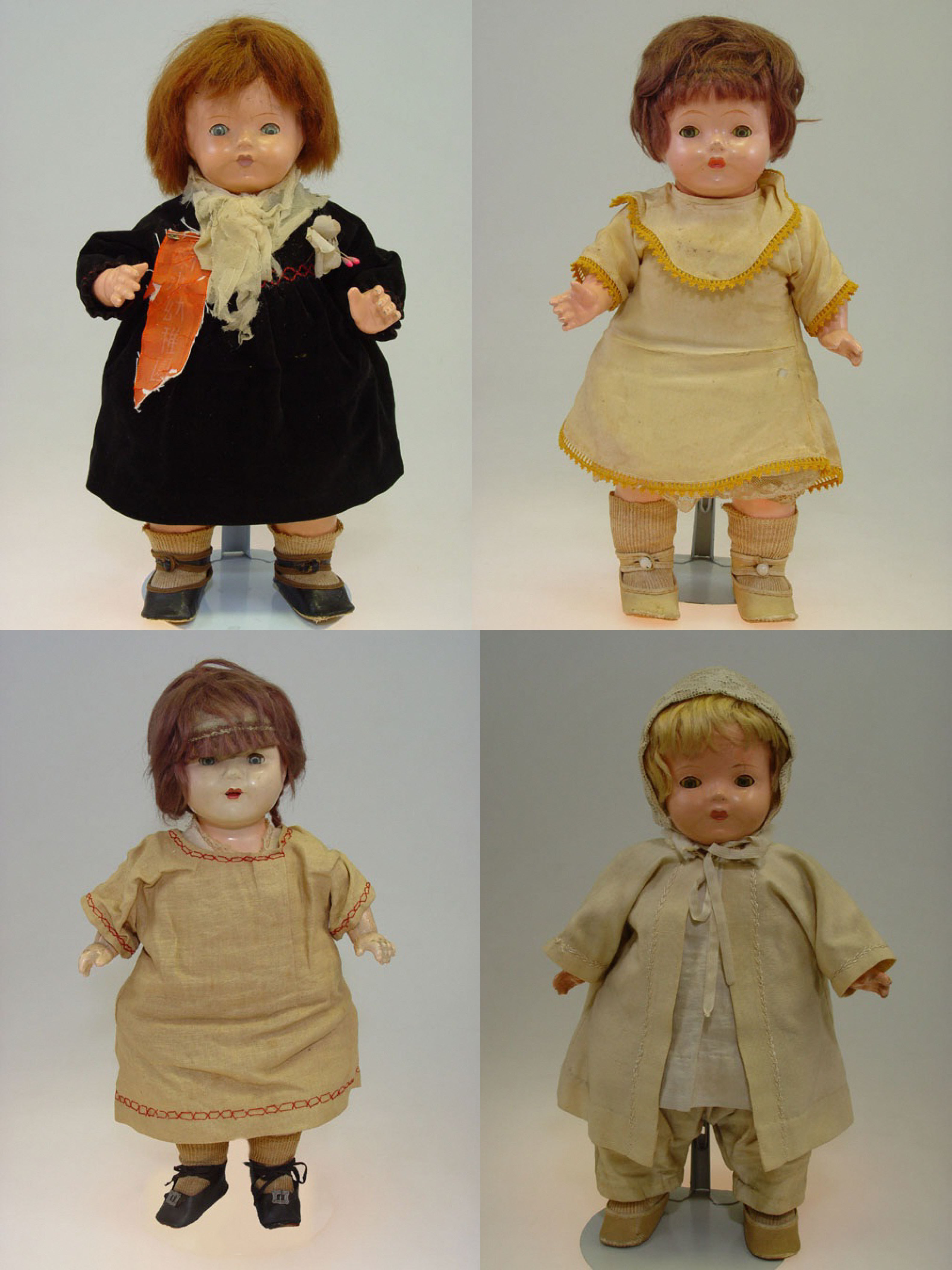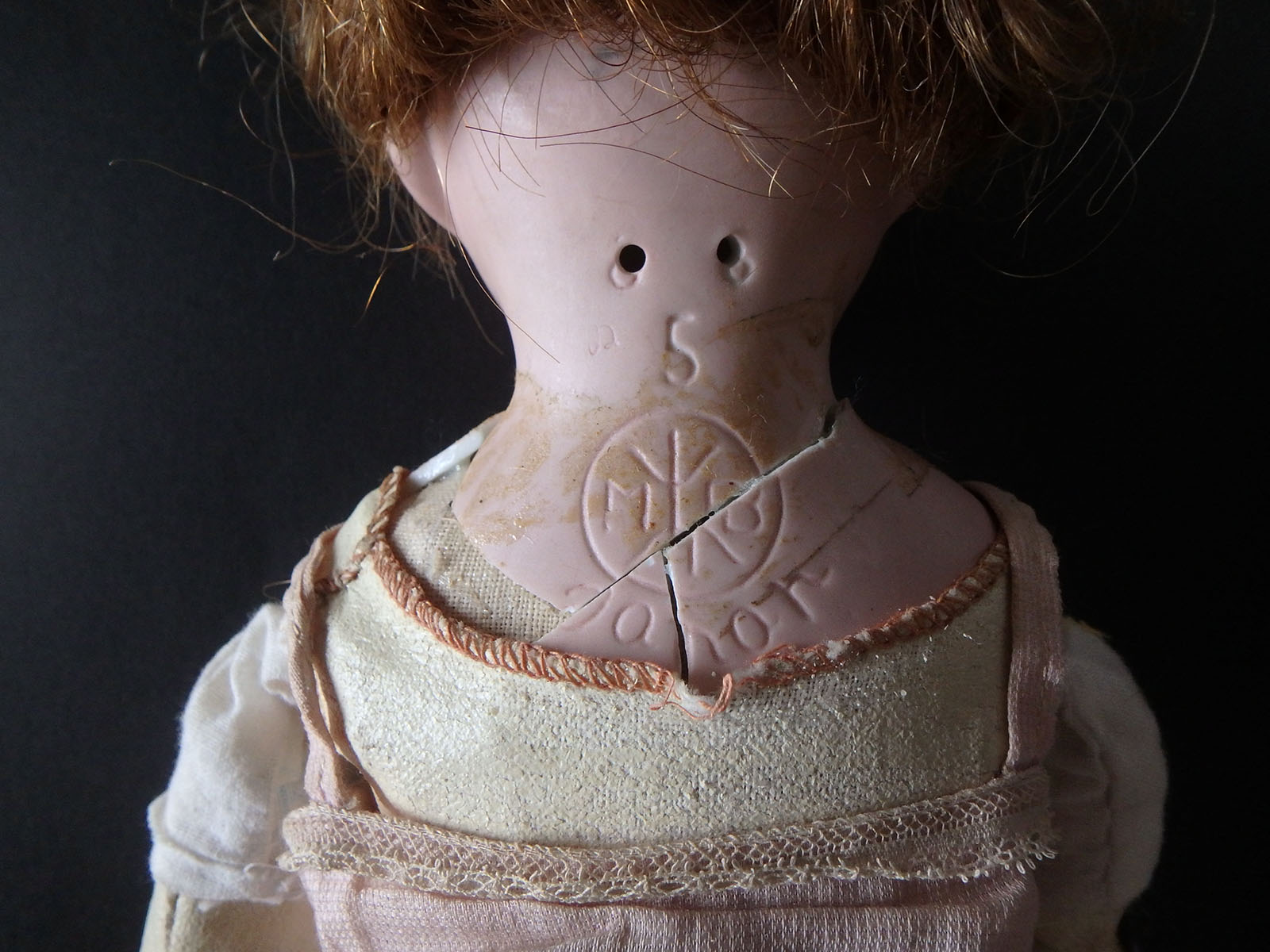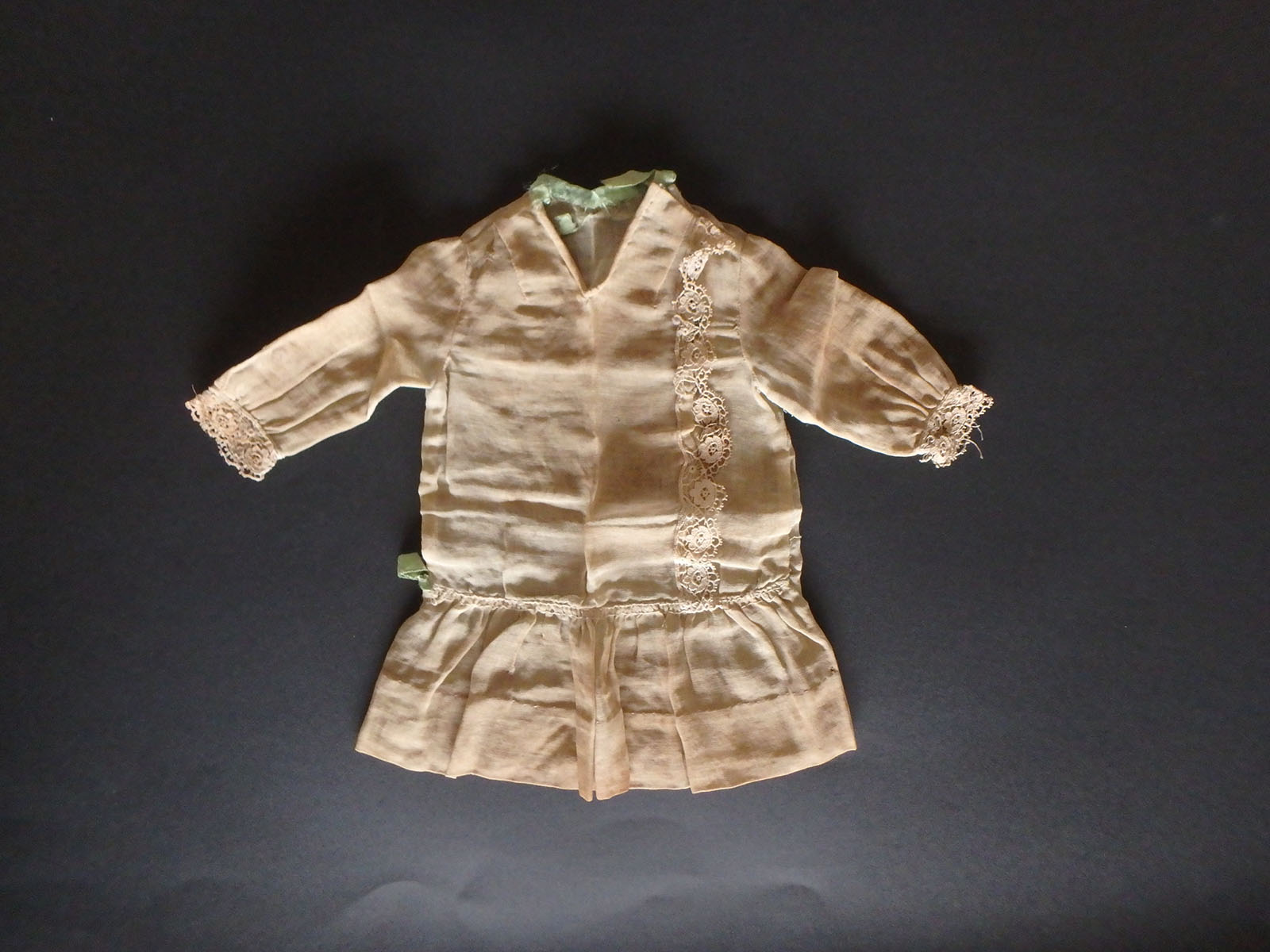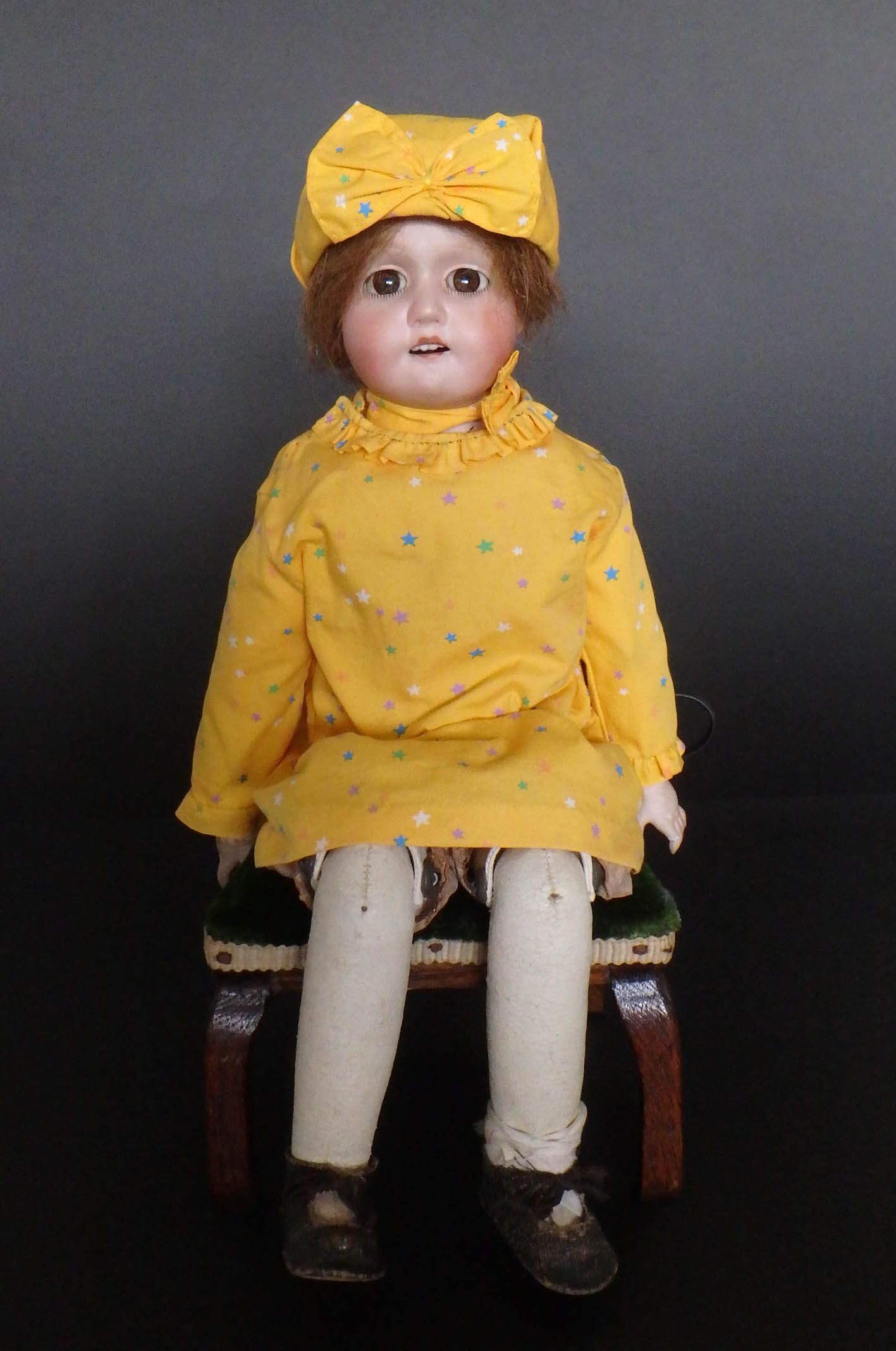公開日 2021年11月12日
Blue-eyed Friendship Doll in Oyama Elementary School
4. Blue-eyed Dolls Coming to Japan
Responding to Gulick’s proposal, children all over the US held bazaars or performed plays in order to raise fund to purchase and ship dolls to Japan.
The dolls were composition dolls, which were made of composite materials composed of pulp, sawdust, glue and clay, and molded and colored. The dolls were dressed, given names and shipped with messages for Japanese children. As many as 12,739 dolls were sent to Japan.

- Blue-eyed Dolls in various costumes
- clockwise from the top left,
- Elena,Nelly,Brosson and Margery
- (owned by Yokohama Doll Museum)
The dolls were about 40 cm tall, dressed in various costumes such as those of babies, nurses, brides, girl scouts and so on. They closed their eyes when laid down, while they uttered ‘mama’ when lifted up to their feet. In 1927, twelve ships, including Siberia and Lisbon, carrying the dolls with their passports, visas and one-way tickets, arrived in the port of Yokohama, in time for Hina Matsuri. On March 3rd, the day of Hina Matsuri, a grand welcome ceremony for the dolls was held at Nippon Youth Assembly Hall in the outer garden of Meiji Shrine, attended by about 2,000 people, including Eiichi Shibusawa, the imperial family members, the officials of the Ministries of Foreign Affairs and of Education, the student representatives from Tokyo elementary schools and the students from the American school.
Betty Ballantine, the representative of the US children, handed a doll to Yukiko Tokugawa, that of Japanese children, who was in the first grade of Gakushuin Elementary School. Afterwards, the dolls were distributed to kindergartens and elementary schools not only throughout Japan but also to Korea, Taiwan, Karafuto (Sakhalin) and Kwantung Leased Territory, Japanese colonies at that time. According to Shibusawa Memorial Museum, 166 dolls were distributed in Kanagawa Prefecture. Among them was the blue-eyed doll named Ruth Jane, distributed to Isehara Town Oyama Elementary School. The following is the process how the doll was found.
The story began with a letter mailed on September 5th, 1987. The letter was written by Michiko Wada (her maiden name was Otsu), an ex-student of Oyama Elementary School, who lived in Atsugi at that time and passed away in October, 1997. The following is what she wrote in the letter;
I am writing this letter driven by nostalgia I feel to be informed that Ruth Jane, the doll sent from the US to promote Japan-US friendship, is still kept safe even after the war. (・・・) I was probably in the sixth grade when Ruth Jane came to us. In my kimono and hakama (a Japanese traditional long skirt), holding Ruth Jane in my arms, I played her role and greeted. As Japanese children, my sister, my classmate Mitsue Hayami (the present hostess of Hayami Inn in Oyama) and Ine Noguchi (the daughter of Utsumi Kageyu Inn in Oyama) received the doll. It seems strange that they wore western-style clothes while I was in Japanese-style clothes, but I had never worn western-style clothes until I entered the girls’ junior high school. I can recollect about half of Ruth Jane’s speech I read; my name is Ruth Jane. I was born in ‘Pu-ri-n-ga-a-ji-o-wa’, a village in the US. I came to Japan, the land of beautiful cherry blossoms, as a representative of American children, in order to make friends with friendly Japanese children. It is true that I miss Dad and Mom, but I’m sure I will be happy if we can get along with each other.
For more than ten years afterwards, the information concerning the blue-eyed doll in Oyama Elementary School was not provided, until March, 2001, when Mr. Maki, the principal of Isehara Municipal Ishida Elementary School at that time, who saw the ‘old’ doll at the Isehara hina doll esxhibition held at the school, indicated that the doll must be one of the blue-eyed friendship dolls. In September that year, the Isehara Board of Education, not having definite information in those days, requested Yokohama Doll Museum to investigate and appraise the doll, which revealed quite interesting and unexpected facts as follows:
1 The doll is about 40cm tall, the same size as the other blue-eyed dolls. It has been kept in a very good condition.
2 While the most of the blue-eyed dolls are composition dolls, the doll in Oyama is a bisque doll (with the ceramic head and the arms). It was manufactured in Japan at Morimura Brothers Co. (present Noritake Co., Ltd.; its mark is engraved at the doll’s shoulder).
3 The doll was one of those made for export market during the seven years from 1915 to 1921.
4 The costume the doll is wearing was newly made, but the original underwear and dress exist.
5 The blue-eyed friendship dolls are supposed to have special passports, the letters written by American children and one-way tickets, but those of the doll in Oyama have not been found yet.
6 The doll is kept in a wooden box, on which the school name (‘Oyama School’) was branded.

- the engraved mark of
- Morimura Brothers Co.on
- Ruth Jane's shoulder

- the original dress

- Ruth Jane
Furthermore, in 2005, Tomoko Shizukuishi, the executive secretary of the committee to investigate the blue-eyed friendship dolls in Miyagi Prefecture, provided the information that No.7 of Oyama Elementary School alumni bulletins, published in November 1st, 1929, is among the collection of Kanagawa Prefectural Library,and there is an article mentioning the doll as follows;
‘The pretty doll, who came a long way across the Pacific Ocean, delighted the children extremely. Her name is Ruth. Several days later, we held the great welcome party for her.’
The article shows that the doll was welcomed by the children with great interests. The principal at that time was Shuichiro Kuroishi.
Taking the evidences given by the people and by the articles concerning Oyama Elementary School into consideration, it is certain that the doll belonging to Oyama Elementary School is among the blue-eyed friendship dolls assembled from all over the US in the movement led by Gulick. The survival of 321 blue-eyed friendship dolls in Japan has been confirmed so far, and 99% of them were mass-produced composition dolls. The exceptions are three bisque dolls, the two of which were made in Germany, and the rest is Ruth Jane, made in Japan by Morimura Brothers Co., miraculously surviving in Oyama Elementary School. Ruth Jane returned to her homeland, as it were. This doll was probably exported to the US before the friendship doll project, privately owned once, contributed by the owner to join the project and became a member of the friendship dolls. Among 12,739 dolls, she was chosen to come to Oyama Elementary School by chance, on the mountainside of Oyama, which has been noted as a sacred mountain where gods and Buddha reside.What made Morimura Brothers Co. (whose founder, Ichizaemon Morimura, as mentioned before, was acquainted with Gulick through the meetings of Kiitsu Kyokai) manufacture bisque dolls? According to Keiko Wakabayashi, a curator of Yokohama Doll Museum, bisque (biscuit porcelain) dolls, with matt skins, were made in Europe, mainly at Jumeau and Bru in France, and at Meissen in Germany from the end of the 19th century to the beginning of the 20th century. The method of making chinaware, originally introduced from China and Japan into Europe, was applied to the production of the dolls. Due to the World War I, however, the German doll industry was obliged to withdraw from the US market. Instead, Morimura Brothers Co. (established in 1878, based in New York City), started manufacturing western dolls with German method at Seto (one of the biggest pottery production areas in Japan) in 1915. Though Morimura dolls got popular, the company was dissolved in 1921 due to the recession in the US. During this period, as many as 3 million dolls were exported, nearly 90 % of which were to the US and Canada.Among them is Ruth Jane, which could be said a ‘miracle doll’. Takehisa Yumeji Museum in Ikaho hot spring area in Gunma Prefecture has now more Morimura dolls than anywhere else in Japan.
Next⇒5. Torei Ningyo (Dolls of Gratitude) Sent across the Pacific Ocean
- 1. Introduction
- 2. Relations between Japan and the US in Those Days
- 3. Doll Exchange Project ~ Gulick and Eiichi Shibusawa
- 4. Blue-eyed Dolls Coming to Japan
- 5. Torei Ningyo (Dolls of Gratitude) Sent across the Pacific Ocean
- 6. From the past to the future
Previous⇒3. Doll Exchange Project ~ Gulick and Eiichi Shibusawa


